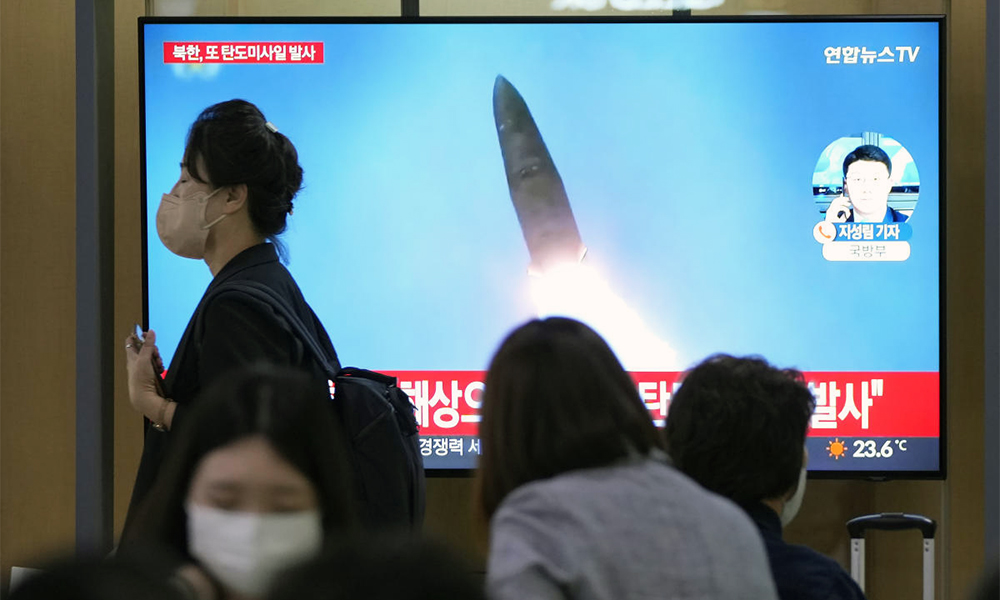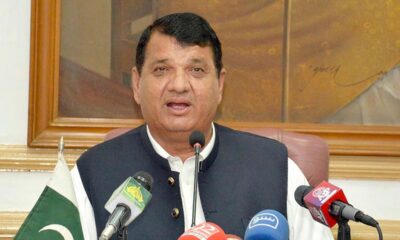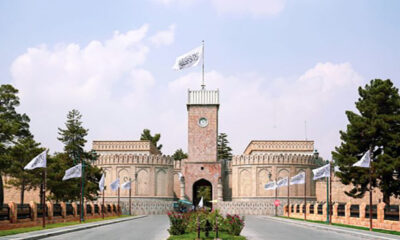Science & Technology
North Korea fires ballistic missiles, marking fourth in a week

North Korea fired two short-range ballistic missiles toward the sea off the east coast on Saturday, South Korea’s military said, marking Pyongyang’s fourth launch in a week as it ratchets up tension around the Korean peninsula, Reuters reported.
The launch comes after the navies of South Korea, the United States and Japan staged trilateral anti-submarine exercises on Friday for the first time in five years, and follows a visit by U.S. Vice President Kamala Harris to the region this week.
According to Reuters the two short-range missiles were launched from Sunan, north of the North Korean capital Pyongyang, South Korea’s Joint Chiefs of Staff said in a statement. It estimated the range at 350 km (220 miles) at 30 km (20 miles) altitude and speed of Mach 6.
Japan’s coast guard reported at least two suspected ballistic missile tests by Pyongyang. The missiles flew 400 km and 350 km, reaching an altitude of 50 km, said Toshiro Ino, state minister of defence.
Tokyo has lodged a protest against the North through diplomatic channels, Ino said, adding the missiles possibly flew an “irregular trajectory” designed to evade missile defence.
The U.S. Indo-Pacific Command said it is aware of the ballistic missile launches and has assessed they do not pose an immediate threat to U.S. personnel or territory or to its allies, read the report.
North Korea fired missiles before and after Harris’ visit to South Korea, extending a record pace in weapons testing this year as it increases the threat of a credible nuclear power that can strike the United States and its allies.
Pyongyang also conducted the first intercontinental ballistic missile test since 2017, Reuters reported.
Analysts see the increased pace of testing as an effort to build operational weapons, as well as to take advantage of a world distracted by the Ukraine conflict and other crises to “normalise” its tests.
“Despite North Korea’s internal weaknesses and international isolation, it is rapidly modernising weapons and taking advantage of a world divided by U.S.-China rivalry and Russia’s annexation of more Ukrainian territory,” said Leif-Eric Easley, a professor of international politics at Ewha University in Seoul.
“The Kim regime is also playing hardball with the Yoon administration while South Korean politics are hobbled by infighting,” referring to South Korean President Yoon Suk-yeol.
Japan’s Defence Ministry said in a report in July the North had been launching short-range missiles that fly low and irregular trajectories, characteristics observed since May 2019 that are likely designed for higher war-fighting effectiveness.
Marking South Korea’s 74th Armed Forces Day, President Yoon condemned what he called recent military provocations by the North and vowed to strengthen joint military drills with the United States.
“Going forward, the government will further strengthen the Korea-U.S. joint exercises, will respond strongly to North Korean provocations and threats by showing them the ‘Alliance in Action’,” Yoon said in a televised speech.
South Korea’s special representative for Korean Peninsula peace and security affairs, Kim Gunn, had telephone calls with his U.S. and Japanese counterparts, in which he said they jointly condemned Pyongyang’s missile tests. He said Saturday’s launch poses a “serious threat to the international community.”
The United Nations Security Council has imposed sanctions against the North for its ballistic missile and nuclear tests. Pyongyang rejects such moves as infringement of its sovereign right to self-defence and space exploration, Reuters reported.
The North has completed preparations for a nuclear test, a window which could open between China’s Communist Party congress in October and the U.S. mid-term elections in November, South Korean lawmakers said on Wednesday.
Science & Technology
Apple loses top phonemaker spot to Samsung as iPhone shipments drop, IDC says

Apple’s (AAPL.O), opens new tab smartphone shipments dropped about 10% in the first quarter of 2024, hurt by intensifying competition by Android smartphone makers aiming for the top spot, data from research firm IDC showed on Sunday.
Global smartphone shipments increased 7.8% to 289.4 million units during January-March, with Samsung (005930.KS), opens new tab, at 20.8% market share, clinching the top phonemaker spot from Apple, Reuters reported.
The iPhone-maker’s steep sales decline comes after its strong performance in the December quarter when it overtook Samsung as the world’s No.1 phone maker. It’s back to the second spot, with 17.3% market share, as Chinese brands such as Huawei gain market share.
Xiaomi, one of China’s top smartphone makers, occupied the third position with a market share of 14.1% during the first quarter, read the report.
South Korea’s Samsung, which launched its latest flagship smartphone lineup – Galaxy S24 series – in the beginning of the year, shipped more than 60 million phones during the period.
Global sales of Galaxy S24 smartphones jumped 8%, compared to last year’s Galaxy S23 series during their first three weeks of availability, data provider Counterpoint previously said.
In the first quarter, Apple shipped 50.1 million iPhones, down from 55.4 million units it shipped same period last year, according to IDC.
Apple’s smartphone shipments in China shrank 2.1% in the final quarter of 2023 from a year earlier.
The drop underscores the challenges facing the U.S. firm in its third biggest market, as some Chinese companies and government agencies limit employees’ use of Apple devices, a measure that mirrors U.S. government restrictions on Chinese apps on security grounds.
The Cupertino, California-based company in June will hold its Worldwide Developers Conference (WWDC), where it will highlight updates to the software powering iPhones, iPads, and other Apple devices.
Investors are closely watching for updates on artificial intelligence development at Apple, which has so far spoken little about incorporating the AI technology into its devices. The company earlier this year lost the crown as the world’s most valuable company to Microsoft (MSFT.O), opens new tab, Reuters reported.
Science & Technology
China launch of relay satellite Queqiao-2 for lunar probe mission successful

China National Space Administration (CNSA) said on Friday its launch of a key signal relay satellite was a “complete success” and it would serve as the communication bridge for its future lunar probe missions for years to come, state media reported.
China launched the satellite Queqiao-2, which was named after a mythological bridge made of magpies, and two miniature satellites, Tiandu-1 and Tiandu-2, on March 20.
Queqiao-2 will be used as a communications bridge between the ground operations on earth and upcoming lunar probe missions on the far side of the moon until at least 2030.
The moon’s near side always faces earth. That means data transfers from the far side are impossible because there is no direct line of sight.
Queqiao-2 researcher and developer Xiong Liang described the satellite as “the main switch” of the whole fourth phase of lunar missions, according to state television CCTV.
“Only when the main switch is flipped on, all the communications can kick off,” Xiong said.
Queqiao-2 will orbit the moon and relay signals to and from the Chang’e-6 mission, which expected to be launched in May. The robotic Chang’e-6 probe will seek to retrieve samples from an ancient basin, acquiring lunar material from the moon’s hidden side for the first time.
Queqiao-2 will also be used as a relay platform for the Chang’e-7 lunar mission in 2026 and the Chang’e-8 mission in 2028.
The functions and performance of Queqiao-2 met mission requirements and it will be able to provide relay communication services for China’s lunar exploration projects and future lunar missions for China and other countries, said the CNSA, according to CCTV.
Queqiao-2 entered its targeted elliptical orbit on April 2 after a correction midway, near-moon braking and orbital manoeuvre around the moon, CNSA said.
The satellite has successfully communicated with Chang’e 4, which was the first spacecraft to perform a soft landing on the far side of the moon and is still carrying out its exploration mission. It also communicated with the Chang’e-6 probe while it is still on the ground earlier this month.
The successful launch of Queqiao-2 comes after the failed launch of another lunar spacecraft DRO-A/B satellites, which was intended to enter the moon’s distant retrograde orbit (DRO).
China has not released any information on whether or not the satellites can be retrieved.
(Reuters)
Science & Technology
Russia aborts planned test launch of new heavy-lift space rocket

Russian space officials on Tuesday aborted the test launch of a new heavy-lift rocket from its far-eastern launch pad.
The Angara-A5 rocket was scheduled to lift off from the Vostochny space launch facility at 0900 GMT Tuesday, but the launch was aborted two minutes before, AP reported.
Yuri Borisov, head of Roscosmos state space corporation, said the automatic safety system canceled the launch after registering a flaw in the oxidizer tank pressurization system.
He said the next launch attempt was set for Wednesday.
Tuesday’s launch was to be the fourth for the Angara-A5, a heavy-lift version of the new Angara family of rockets that has been developed to replace the Soviet-designed Proton rockets.
-

 Sport5 days ago
Sport5 days agoAfghanistan Champions League kicks off with grand opening ceremony
-

 Latest News4 days ago
Latest News4 days agoPakistan’s frontiers minister stresses ‘dignified’ return of Afghan refugees
-

 Regional3 days ago
Regional3 days agoIranian president lands in Pakistan for three-day visit to mend ties
-

 Climate Change4 days ago
Climate Change4 days agoMassive river flooding expected in China, threatening millions
-

 Latest News4 days ago
Latest News4 days agoChinese keen to invest in Panjshir-Kabul water conduit project
-

 Latest News2 days ago
Latest News2 days agoRashid Khan named AWCC’s brand ambassador
-

 World4 days ago
World4 days agoTwo Japan navy helicopters crash, one body found, 7 missing
-

 Sport3 days ago
Sport3 days agoKolkata beat Bengaluru by one run in IPL as Kohli fumes at dismissal
























